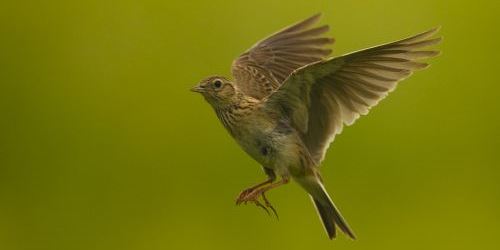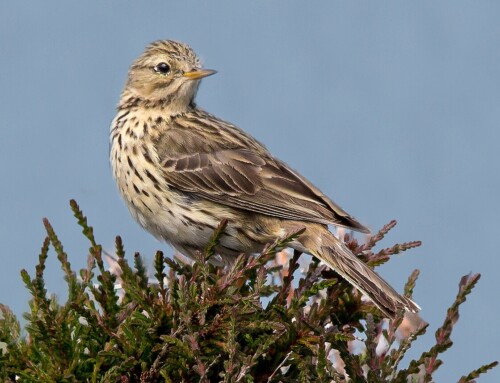Bare patches and additional tramlines increase suitability of conventional arable land for the Skylark
LINKED PAPER
Effect of Sky Lark plots and additional tramlines on territory densities of the Sky Lark Alauda arvensis in an intensively managed agricultural landscape. Schmidt, J.U., Eilers, A., Schimkat, M., Krause-Heiber, J., Timm, A., Nachtigall, W. & Kleber, A. 2017. Bird Study. DOI: 10.1080/00063657.2016.1271394. VIEW
The Eurasian Skylark, Alauda arvensis, is the most widespread, best-adapted and probably most-studied farmland bird species in Europe. Nevertheless, rapid declines occurred during the last decades and in some regions this well-known species is now rare or even extinct. The decline of this formerly ubiquitous generalist gives us reason to fear the silent spring is approaching.
Many studies have supported the evidence that modern agriculture is responsible for this dramatic decrease (e.g. Guerrero et al. 2012). It has also been shown that less intensive farming practices, such as organic farming, provide much better habitats (e.g. Wilcox et al. 2014). Unfortunately, it is not to be expected that organic farming will spread out over most of the European farmland during the next years, so we still need solutions to enhance conventional arable land for the Skylark.
One of the main problems that Skylarks encounter in intensively managed fields with winter cereals or oilseed rape is the dense sward (Fig. 1), which is possible due to fungicide spraying. The birds are simply unable to penetrate these stands, find no place to land or cannot move at the ground to find food. Odderskær et al. (1997) were the first to have the idea of opening the sward artificially by leaving bare patches of about 20 m², thus artificially replicating heterogeneity that formerly occurred naturally.

Such small patches of bare ground (Fig. 2), randomly dispersed within the field, were tested successfully some years later in England within winter cereals. These patches, commonly referred to as ‘skylark plots’, provided access to otherwise dense crops, hence increasing territory densities and prolonging the use of winter cereal fields until the end of the breeding season (e.g. Morris et al. 2004, 2007). Additionally, wide-spaced rows and wild flower strips were tested more or less successfully (e.g. Morris et al. 2004, 2007, Fischer et al. 2009). Especially wide-spaced rows, through which a reduced crop density can be achieved by leaving every second seed row unsown, were not as successful as expected. This was due to the fact that the plants used the extra space for vigorous growth, closing the canopy as fast as at fields with normal seed row width.

In our project we had the overall aim to find and test measures (so-called agri-environment schemes, AES) for the agri-environmental programme of Saxony, a federal state in the eastern part of Germany. As we started, we had (besides many more) three main questions:
- Would the skylark plots work as well as in England if they were used in a central European environment?
- Could we find a way to enhance the success of wide-spaced rows?
- What would the farmers think about the measures?
The study was multiannual, encompassing the years 2010-2013. All sites were conventionally managed fields. Each field included a test area, on which measures were applied and a control area. The farmers could choose between skylark plots (ca. 20m² each, to be established in a density of about two per hectare) and additional tramlines. The latter was our alternative to the wide-spaced rows. In contrast to standard tramlines, the additional ones were placed in a greater density of 6-12 m (Fig. 3) and ended about 20 m away from the field-encircling headlands to reduce predation risk.

We then carried out a systematic mapping of Skylark territories at the whole field to reveal potential differences between test and control sites. Early (1.4.-30.5.) and late (1.6.-15.7.) parts of the breeding season were handled separately to examine temporal changes of habitat suitability. Statistical modelling was conducted using R to identify factors that influence these effects. To evaluate practicability and acceptance of the measures by the farmers, failures and repetition rates in consecutive years were documented.
Both measures proved to be of great benefit for the Skylark (Fig. 4). The territory densities almost doubled by the arrangement of skylark plots in winter cereals, thus demonstrating their effectiveness outside of England in a more continental environment. During the late season, densities at sites with skylark plots were even higher than densities at control sites during the early season, which are usually higher. Our test of skylark plots in winter oilseed rape also yielded promising results and extends the possible application as AES towards an otherwise rather unsuitable crop. The use of additional tramlines instead of double-spaced rows led to remarkably better results. Especially the territory densities in the late breeding season are comparable to those of fields with skylark plots. This makes the tramlines an alternative to skylark plots, although the tramlines need more area and therefore take more land out of production.

Despite the overall relatively easy implementation of both measures, especially skylark plots turned out to be surprisingly challenging for the farmers. At about two thirds of the test fields some kind of error occurred. To match the exact number of patches was the greatest source of error. However, taking into account that some plots more or less could still be acceptable for an AES, these errors are negligible. Both measures proved to be well-accepted by the farmers.
Skylark plots and additional tramlines are beneficial AES for the Skylark. They can be easily implemented and should be promoted to bring them to as many fields as possible. Only large scale application will provide positive effects for the declining Skylark populations.
References and further reading
Fischer, J., Jenny, M. & Jenni, L. 2009. Suitability of patches and in-field strips for Skylarks Alauda arvensis in a small-parcelled mixed farming area. Bird Study 56: 34–42. VIEW
Guerrero, I., Morales, M.B., Oñate, J.J., Geiger, F., Berendse, F., de Snoo, G., Eggers, S., Pärt, T., Bengtsson, J., Clement, L.W., Weisser, W.W., Olszewski, A., Ceryngier, P., Hawro, V., Liira, J., Aavik, T., Fischer, C., Flohre, A., Thies, C. & Tscharntke, T. 2012. Response of ground-nesting farmland birds to agricultural intensification across Europe – Landscape and field level management factors. Biological Conservation 152: 74–80. VIEW
Morris, A.J., Holland, J.M., Smith, B. & Jones, N.E. 2004. Sustainable Arable Farming For an Improved Environment (SAFFIE): managing winter wheat sward structure for skylarks Alauda arvensis. IBIS 146: 155–162. VIEW
Morris, A.J., Smith, B., Jones, N.E. & Cook, S.K. 2007. Manipulate within crop agronomy to increase biodiversity – Crop architecture. In Clarke, J.H., Cook, S.K., Harris, D., Wiltshire, J.J.J., Henderson, I.G., Jones, N.E., Boatman, N.D., Potts, S.G., Westbury, D.B., Woodcock, B.A., Ramsay, A.J., Pywell, R.F., Goldsworthy, P.E., Holland, J.M., Smith, B.M., Tipples, J., Morris, A.J., Chapman, P. & Edwards, P. (eds) The SAFFIE Project Report. HGCA Project Report 416: 21–107. Boxworth, UK: ADAS. VIEW
Odderskær, P., Prang, A., Poulsen, J.G., Andersen, P.N. & Elmegaard, N. 1997. Skylark (Alauda arvensis) utilization of micro-habitats in spring barley fields. Agriculture, Ecosystems & Environment 62: 21–29. VIEW
Wilcox, J.C., Barbottin, A., Durant, D., Tichit, M. & Makowski, D. 2014. Farmland birds and arable farming, a meta-analysis. Sustainable Agriculture Reviews 13: 35–63. VIEW
Image credit
Featured image: Eurasian Skylark, Alauda arvensis © Peter Goldmann
If you want to write about your research in #theBOUblog, then please see here.





